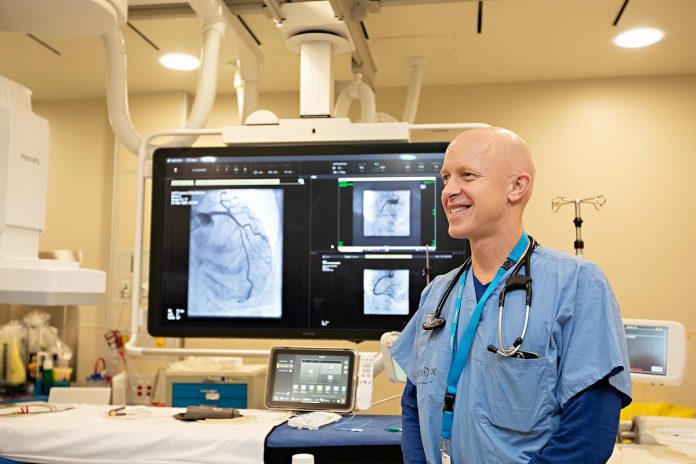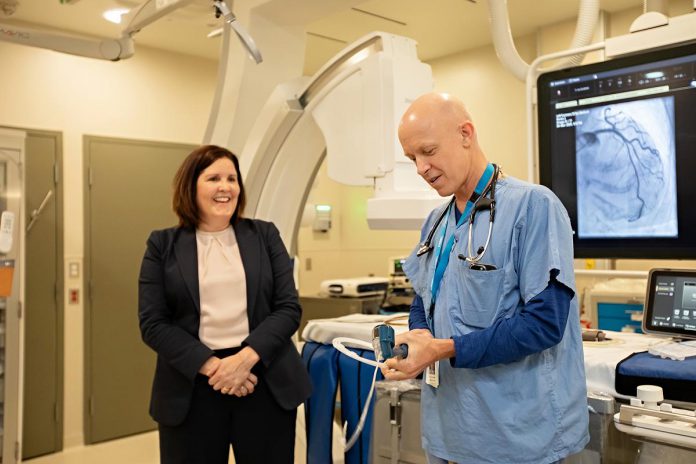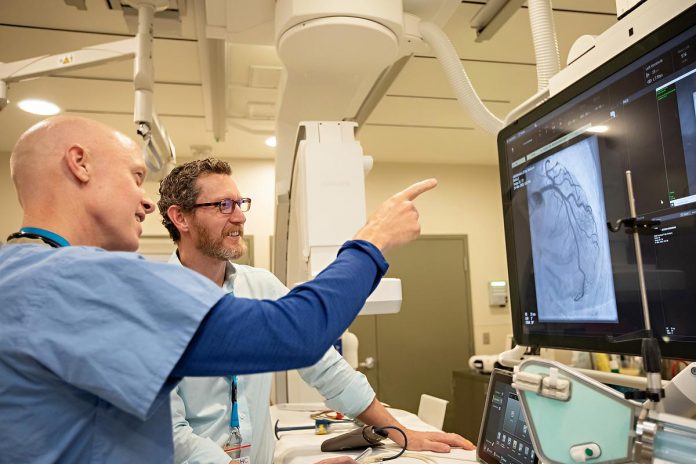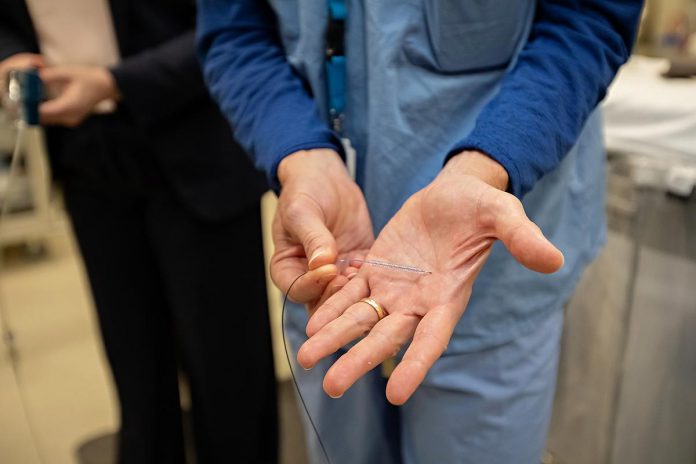
With the help of a $3.55 million investment from the community, the cardiac catheterization laboratory at the Peterborough Regional Health Centre (PRHC) has been equipped with state-of-the-art technology that can stop a heart attack in its tracks.
On Tuesday afternoon (March 25) at the hospital, a media tour was held for the first time to showcase the two cardiac cath lab suites that were renovated and upgraded between September 2021 and December 2022 to allow doctors to perform minimally invasive cardiac procedures more safely and effectively using tools that didn’t exist when PRHC opened.
“The cath lab is one of the first investments that we made with $3.55 million investment fully funded by the community,” said PRHC Foundation president and CEO Lesley Heighway, who hosted the event. “Gifts of all levels brought this to fruition.”
Upgrades to PRHC’s cath lab, which serves cardiac patients from the city and county of Peterborough, Kawartha Lakes, Haliburton County, North Hastings, Northumberland County, and Durham Region, were identified by the hospital as a priority care area when the PRHC Foundation first launched its $60 million Campaign for PRHC, the largest to date, in 2020.
Fundraising took place between 2020 and 2023 with grateful patients sharing their experiences and fundraising appeals going out to the public. Businesses, organizations, and individuals held their own fundraising challenges or gave through one-time or monthly donations to help bring world-class cardiac care to the regional hospital.
PRHC interventional cardiologist and head of cardiology Dr. Warren Ball led the media tour, giving demonstrations of the state-of-the-art tools in the two suites while highlighting how essential the advancements are to patient care.

“Time is muscle as we say in the cath lab, so the sooner we get that blocker reopened, the less muscle damage and disability that you’re going to have going forward,” Dr. Ball said. “Having that care so close to home is essential.”
Coronary artery disease is caused by a buildup of fatty deposits (called plaque) on the walls of the artery that can block the flow of blood to the heart. Many people only find out they have the disease when they have a heart attack, which happens to somebody in Canada every seven minutes. Almost 16,000 Canadians die each year as a result of a heart attack — many before they even get to a hospital.
Interventional cardiologists open a blocked artery using percutaneous coronary intervention, commonly called angioplasty, which involves temporarily inserting and inflating a tiny balloon where the artery is clogged to help widen the artery. Angioplasty is often combined with a cardiac stenting procedure, where a small wire mesh tube called a stent is permanently placed in the artery to keep it open and decrease its chance of narrowing again.
While PRHC began offering angioplasty procedures in 2012, preventing the need for patients in the region to travel to other hospitals for the treatment, Dr. Ball explained that what was then state-of-the-art technology no longer provided the high-resolution imagery needed to make the most accurate assessments.
Today, when PRHC’s interventional cardiologists perform an angiogram, which involves injecting dye into the arteries and using X-rays to identify blockages, the procedure results in the highest definition images possible, allow doctors to accurately diagnose and treat coronary blockages and stop heart attacks.
“That procedure might be as quick as half an hour to 45 minutes to get pictures and then the whole procedure to place the stent and fix it is maybe another 45 minutes,” said Dr. Ball. “In an hour or hour and a half the artery is open, and hopefully you’re feeling better — and we save some heart muscle.”

With the donor-funded upgrades, the cath lab suites now have the technology to seamlessly integrate multiple complementary imaging tools with bedside controls to dramatically shorten the time for even complex procedures, while delivering up to 75 per cent less radiation exposure to patients than the older generation systems.
“For patients, the amount of radiation they get is minuscule for one procedure,” Dr. Ball said, explaining the importance of minimizing exposure since the lifetime exposure to all forms of radiation, such as from chest X-rays, CAT scans, and angiograms, can increase cancer risk.
“The risk (from one procedure) is extremely low, but obviously if all parts of healthcare can deliver that high-quality care with as little risk as possible, that’s the benefit.”
The two renovated suites opened in March 2022 and December 2022 respectively, and have since performed 5,872 cardiac procedures (as of March 16, 2025), averaging 2,500 procedures in a year, 300 of which included stenting while a heart attack was taking place.
Dr. Ball explained that there is still more to go when it comes to making advancements in cardiac care at PRHC. The next goal through the $60 million Campaign for PRHC is to add a third cath lab that will introduce minimally invasive electrophysiology technology to assess and diagnose electrical conditions of the heart, such as abnormal heart rhythms and arrhythmia.
“Those patients still have to go out of town to another bigger centre to have those procedures done,” Dr. Ball pointed out. “We’re trying to get that next foundational piece of our cardiac program brought to Peterborough.”

Heighway noted that, when PRHC was built, it included space for a third cardiac lab, “so that’s a key part of our $60 million campaign.”
Dr. Ball added that the addition of the third cath lab will mean the hospital will need to recruit additional specialists. Given that many physicians are studying with and learning from modern equipment and technology, those are the tools they are looking for when it comes to selecting a place of work.
“Having the latest and greatest technology is key in a time when there’s a doctor shortage and we’re trying to compete will all the hospitals across the country to bring new talent to town,” said Dr.Ball, who noted that PRHC’s recently hired interventional cardiologist came to the hospital in 2022 in part because of the cath lab upgrades.
With a third cath lab for electrophysiology studies, Dr. Ball said, “we could literally say that we had the newest and latest criteria and technology in the entire province.”
Dr. Ball also noted the government doesn’t fund equipment and technology for hospitals, highlighting how essential the community donors were to making cath lab upgrades. Since 2020, $52.9 million has already been raised towards the PRHC Foundation’s $60 million goal.
“It’s the generosity of the foundation and their donors that fund all of these technologies,” Dr. Ball said. “We say thanks to the donors because without them, none of this is possible.”



























